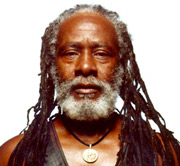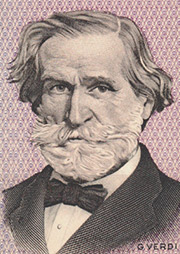Burning Spear: Slavery Days (1975)
 Winston Rodney, also known as Burning Spear (technically it would be the name of his band, but he IS the band), is an almost legendary figure in Jamaica. Born in 1945, he’s an original Rastaman and a true Roots Reggae star. His albums, and especially his concerts, are meant to be political and spiritual experiences rather than just live music. His albums are called Resistence, People of the World, Jah Kingdom, Social Living, or the one where this song comes from, Marcus Garvey (the father figure of Rastafarianism). He sings about religion, the condition of jamaicans of african descent (the vast majority), his hopes for a world united. In this he’s very similar to Bob Marley. But where Marley wrote songs (with a chorus, a verse, etc.), Rodney uses much looser, more archaic forms, often staying on the same two chords for the whole tune (as in this case), and frequently ad libbing.
Winston Rodney, also known as Burning Spear (technically it would be the name of his band, but he IS the band), is an almost legendary figure in Jamaica. Born in 1945, he’s an original Rastaman and a true Roots Reggae star. His albums, and especially his concerts, are meant to be political and spiritual experiences rather than just live music. His albums are called Resistence, People of the World, Jah Kingdom, Social Living, or the one where this song comes from, Marcus Garvey (the father figure of Rastafarianism). He sings about religion, the condition of jamaicans of african descent (the vast majority), his hopes for a world united. In this he’s very similar to Bob Marley. But where Marley wrote songs (with a chorus, a verse, etc.), Rodney uses much looser, more archaic forms, often staying on the same two chords for the whole tune (as in this case), and frequently ad libbing.
Slavery Days, Burning Spear’s most famous song, is a call to remember the days of slavery. Of course if your ancestors were slaves (something hard even to imagine), this is a very powerful message, which makes this a very powerful tune (as it happens with many of Marley’s songs). The repeated question: “Do you remember?” feels like a shamanic call, with obvious political overtones. There’s a number of covers of this simple yet not easy song. My favorite is the slow, spiritual rendition☊ by Third World (on the band’s 1976 self titled first album). This track is also a staple of Burning Spear’s incendiary live concerts, where it lasts for almost ten minutes♾ (and, in some cases, turns into something completely different♾- but no less compelling).
buy from amazon • buy from itunes • play on spotify
Grace Jones: Slave To The Rhythm (1985)
 This tasty track was created by one of the best sound chefs of the 1980s: Trevor Horn, the same man who cooked Frankie Goes To Hollywood‘s seminal debut album Welcome To The Pleasure Dome (and many more). It is said (on the song’s Wikipedia page) that “Horn worked on the song endlessly and had hoped it would become one of his biggest and most successful creations.” The singer of course is Grace Jones, with Jean Paul Goude doing her style and visual. Interesting fact: Goude is also responsible for the 2014 Kim Kardashian breaks the internet photoshoot for Paper magazine (the one starring her butt). If you google it, you can see some more images – and they REALLY look like Goude’s work with Jones. More evidence these people were far sighted.
This tasty track was created by one of the best sound chefs of the 1980s: Trevor Horn, the same man who cooked Frankie Goes To Hollywood‘s seminal debut album Welcome To The Pleasure Dome (and many more). It is said (on the song’s Wikipedia page) that “Horn worked on the song endlessly and had hoped it would become one of his biggest and most successful creations.” The singer of course is Grace Jones, with Jean Paul Goude doing her style and visual. Interesting fact: Goude is also responsible for the 2014 Kim Kardashian breaks the internet photoshoot for Paper magazine (the one starring her butt). If you google it, you can see some more images – and they REALLY look like Goude’s work with Jones. More evidence these people were far sighted.
Slave To The Rhythm has been one of the very first dance hits (it’s set to a funky Go go beat) to undergo the kind of treatment dance music gets today: multiple versions, remixes, acappellas, etc. The album Slave To The Rhythm (1985), includes three versions of the song: Jones the Rhythm☊, (a faster, martial version), Slave To The Rhythm☊ and Ladies and Gentlemen: Miss Grace Jones☊ (which is the single everyone calls Slave To The Rhythm). In most versions, you hear actor Ian McShane reciting passages of Jones’ biography (penned by Goude), as well as excerpts from an interview where Jones talks about her life. But wait: a few months later the maxi single came out, with more versions. First of all Slave To The Rhythm (blooded)☊, the proper extended dance version. Then there’s the album single, in a shorter, radio version, plus a fantastic instrumental vamp, entitled Junk Yard☊. I’ll spare you the 1994 CD reissue, with more remixes.
Jean Paul Goude’s work with Grace Jones is one of the most interesting artistic collaborations of the 1980s (and more: the two were briefly married and have a son). Through Jones’ videoclips and photoshoots (many of them post-produced in a very Photoshop-like style, years before computer graphics), her clothing and their other visual work (like the Citroen CX Tv ad where Jones turns into a giant car eating creature), they created a very powerful, complex, definitely afrofuturistic and, at the time, even somewhat edgy and controversial imagery. In the video for Slave To The Rhythm you can see a good portion of their work together – including parts of the Citroen ad.
buy from amazon • buy from itunes • play on spotify
Giuseppe Verdi: Va, pensiero (1842)

Giuseppe Verdi on an old italian 1000 lira bill.
If Opera had hits, Va, Pensiero would be a smash. It’s the most famous aria from Verdi’s Nabucco, interestingly performed by a choir (arias are often vehicles for star singers to shine). In the narration, partly inspired by Psalm 137 from the Bible, Va, Pensiero is the chant of the Jews, exiled and enslaved by babylonian king Nabucco (whose actual name was Nebuchadnezzar II), yearning for their lost land*. But this isn’t educational music: “The historical events are used as background for a romantic and political plot.”
Throughout the years, Va, Pensiero has had a number of meanings attached to it. Italy in 1842, when the opera premiered, was a divided country, but there was a strong movement that struggled for liberation (from foreign powers: Milan was part of the Austrian empire, and in the following years it became the center of a fierce and violent battle for independence) and unification of Italy, which eventually happened in 1861.
More recently, Lega Nord (an italian xenophobic and northern supremacist right wing party) and other politicians, periodically propose to replace Italy’s current anthem (L’Inno di Mameli, a pompous and somewhat hilarious piece of music☊) with Va, Pensiero. It would be a vast musical improvement, but there seem to be a few inconsistencies. Presently, italians are not slaves (but of their inability to produce a credible political class), and their country is not lost: not yet, at least.
Va, Pensiero is in the public domain. There are a few versions available for download on Archive.org, including this one, performed in 1969 by the London Symphony Orchestra and the Ambrosian Singers, conducted by Claudio Abbado.
* Interestingly, as a related song, Wikipedia suggests the 1970 Melodians huge Reggae hit Rivers of Babylon☊, having been inspired by the same biblical verse. Which brings us back to the top of this page.
Runner ups
Nine Inch Nails: Happiness In Slavery♾ (1992) (Warning: very graphic, very NSFW video).
Bryan Ferry: Slave to love♾ (1985)